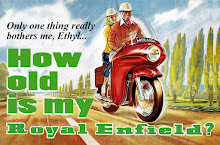 Royal Enfield has unleashed a series of ads in India highlighting individual Royal Enfield buyers and their personalities. Each is shown with his or her bike. The people used are artists, performers, entrepreneurs, even a "gentleman farmer." The message is that they are individualists who chose Royal Enfield over all others and would settle for nothing less.
Royal Enfield has unleashed a series of ads in India highlighting individual Royal Enfield buyers and their personalities. Each is shown with his or her bike. The people used are artists, performers, entrepreneurs, even a "gentleman farmer." The message is that they are individualists who chose Royal Enfield over all others and would settle for nothing less.One is shown above and you can see more here.
In the United States, these sorts of ads are often referred to as "Dewar's Profiles," after an original series of whiskey ads that pioneered this format. What would a "Dewar's Profile" of a typical U.S. Royal Enfield owner be like? Here's my guess:
Sex: Male. This is probably true of all motorcyclists in all lands.
Age: Middle or more. Part of the Royal Enfield's special appeal is its link to the great British motorcycle industry, which largely disappeared by 1975. To have been 10 in 1975 you'd have to be at least 43 today.
Education: Above average. Royal Enfield customers have to be better informed to even be aware of the make. They are likely to be trained and constant consumers of information.
Income: Above average. In most of the United States a motorcycle is a second or third vehicle, since it can not be used in winter. The Royal Enfield has its limitations (speed) even as an all-purpose motorcycle, so it may be the second bike in a collection.
Marital status: Married with children who are grown or soon will be. This accounts for all those sidecar purchases, for one thing. But the real reason is that the Royal Enfield in the United States is not a "chick magnet." Single men can choose between plenty of other machines that offer more sex appeal.
Individuality: Above average. Royal Enfield buyers in the United States have chosen not to try to keep up with the crowd. They don't run with a crowd. For one thing, the crowd is going much faster.
But who cares what the "typical" Royal Enfield owner is like? Today's buyers are finding their way to Royal Enfield on their own. Because it is a unique product, Royal Enfield has an absolute lock on these buyers. The only competition (perhaps from Ural) is miles behind.
But once an older buyer has paid for the bike, he likely won't buy a second or replace it for years. Since this individualistic owner doesn't join clubs, he isn't influencing many others to buy. Royal Enfield has to be concerned with who will buy its products tomorrow.
That customer is likely to be younger, less aware of the heritage, more social, more female and less married. These considerations may not change the product much, since it can not change much without losing its special appeal. But advertising could target these new buyers now -- perhaps with Dewar's profiles of them.































speaking as a chick, I think Enfields are tremendous magnets.
ReplyDelete